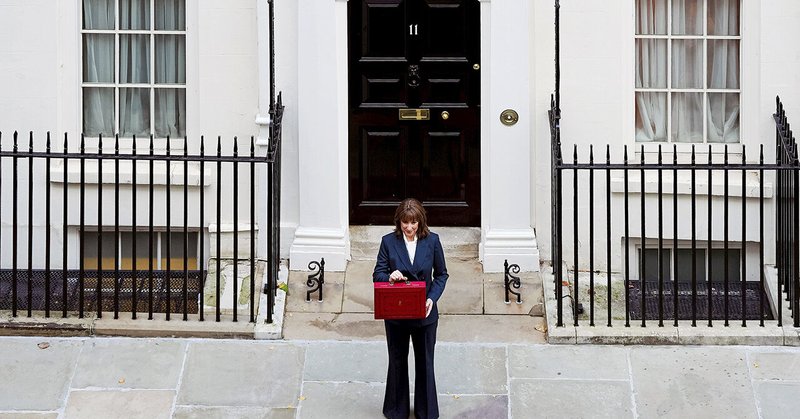
Henry Curr
@currhenry
Followers
7K
Following
806
Media
151
Statuses
2K
Economics editor @TheEconomist. Co-host of Inside Economics. Visiting Fellow @NuffieldCollege. Views mine only.
London, England
Joined February 2013
@currhenry "[Taxes] will reach 38% of GDP, not far off Norway and Sweden." But the Nordic countries' high tax-to-GDP ratios are partly due to a clawback effect - benefits are heavily taxed (directly and indirectly). Net of that the UK will reach Swedish levels. https://t.co/GKMN0J9Gaz
0
1
3
Reeves has tried to pin £26bn of tax rises on a forecast that is only £6bn worse, to fund new welfare spending that was not in Labour's manifesto, having promised not to raise taxes on working people. Regardless of the merits of the policies, how is this not dishonest?
0
1
4
"The budget was further proof of a strangely overlooked fact in British politics: Ms Reeves is a chancellor in the most economically left-wing government of the past five decades." https://t.co/tAOfJTviyI
economist.com
An obvious fact. But still an overlooked one
1
1
6
"The [OBR] gave a sunnier-than-expected outlook for the public finances, raising its deficit forecast for 2029-30 by only £6bn...she produced a vintage Labour tax-and-spend package: £26bn in tax increases in 2029-30 and £11bn in extra spending." https://t.co/qADrJc3GDD
economist.com
And ducked the painful choices needed to revive the economy
1
1
0
The bodge-it budget "With the deficit still gaping at 4.5% of GDP, Ms Reeves succumbed to her own worst instincts and those of her backbenchers by increasing borrowing, relative to her previous plans, for four years" My leader and our cover story https://t.co/iE5Coigewk
economist.com
Without ambitious reform, the country will not thrive
7
6
16
And that's not just because of the forecast downgrade. Policy loosens too (black dot above white dot) until 2029-30
0
0
1
Oh for goodness sake. This is ridiculous. Will lead to challenges over exactly which side of the line properties fall, and fail to deal with fact that super expensive properties will still be undertaxed. Why not do as a proportion of estimated value?
And a council tax surcharge. The design looks *terrible*. Slabs/thresholds which will distort the market
23
48
294
This is pie in the sky thinking. Utterly incorrect. You can institute a regime of capital controls and financial repression but you literally can’t have free markets and buck them. If you’re going go the dictator route though, best be honest about your intentions.
🤣🤣🤣. Government can always discipline the markets. It doesn’t need to sell bonds, it chooses the interest rate, and if markets misbehave, govt has infinite £ firepower to put markets in their place. Rich people only have power if we let them, @afneil.
19
10
80
The fact of the matter is that illiberalism and rejections of neutrality have failed far, far more often and with much dire consequences than any failures of Enlightenment liberalism.
The number one political conflict on the Right in 2025 is not over Israel or Trump or Vance or the Constitution or who Tucker Carlson is allowed to interview. It’s over the fact that enormous structural components of the Enlightenment’s political project has failed. And the
20
41
387
The UK has the most progressive tax system in the developed world, argues @jburnmurdoch. As @duncanrobinson wrote for @TheEconomist, the Tories created an unbelievably progressive system. https://t.co/xwciYwPQzD
https://t.co/WHlsKzx5oj
4
12
54
🧵 CAMBRIDGE: New data. Clear preferences. The public want buildings that fit in, not stick out. A new poll by @DeltapollUK for @createstreets finds 71% of Britons prefer a traditional alternative to the current design for the Christ’s College library. Here’s why it matters ⬇️
22
53
397
Fiscal dominance watch. In US, Trump demands lower rates to make the debt easier to service. In Japan, new PM says BOJ should not tighten. In UK, Farage opposes QT. And now in the eurozone ...
Jordan Bardella has controversially suggested that the European Central Bank could use quantitative easing to help manage France’s debt, which stands at nearly 116% of GDP. With a credible five-year growth plan, he says it could be in the common interest
8
47
167
Debt across advanced economies is higher than ever. Our business affairs editor, @r_shanbhogue, and our economics editor, @currhenry, unpack the crisis brewing in countries’ finances. Learn how disaster can be avoided: https://t.co/E2ycg2LbIp
15
18
45
Tax policy on the British left is pure "anti-bedtime left". Bizarre idea that you can have a big social democratic welfare state without everyone contributing properly
40
122
641
Never understood the consistent appeal of Liz Truss revisionism. A few points: -- Paying for ~1.5% of GDP worth of tax cuts entirely through deficit expansion is, no matter the global macro environment, crackers. -- Doing so when that also means a giant dose of fiscal easing in
The legendary "Liz Truss" moment was little to do with Liz Truss and a lot to do with an overleveraged gilts market colliding with a sharp, global rise in interest rates. Whatever you think of Truss, the problem with blaming her means you misdiagnose the issue. (1/3)
23
54
367
A withering critique of British energy policy. "...the future costs of energy in Britain are going to stay high and remain amongst the highest in the developed world...Britain is not going to have cheap energy any time soon – unless there is radical policy action."
Despite what politicians would have us believe, British energy policy is not cheap, not home-grown and not secure. Read my latest analysis here: https://t.co/eOxRK771r4 Sign up to my mailing list here: https://t.co/k7MHXFipE3.
#sustainableeconomy
0
0
2


















